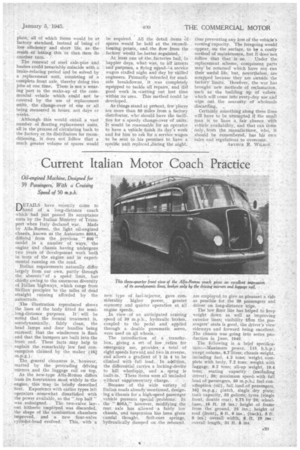Current Italian Motor Coach Practice Oil-engined Machine, Designed for 39 Passengers; With a Cruising Speed of 50 m.p.h.
Page 25

If you've noticed an error in this article please click here to report it so we can fix it.
DETAILS have reeently come to 1.-/hand of a long-distance coach which had just passed its acceptance tests by the Italian Ministry of Transport when Italy declared war. Made by Alfa-Romeo, the light oil-engined chassis, known as the Autocarro 800A," differed from the previous " 800 " model in a number of ways,' the engine and chassis having undergone two years of development work both
• in tests of the engine and in experimental running on the road.
Italian requirements naturally differ largely from our own, partly through the absenee ; of a speed limit, but • chiefly owing to the enormous diversity of Italian highways, which range from Sicilian precipice to the miles of dead straight running afforded by the autostrade.
The illustration reproduced shows the lines of the body fitted for semilong-distance purposes. It will be noted that the frontal treatment is, aerodynamically, fairly clean, the head lamps and door handles being recessed; that the windscreen is flush and that the bumpers are built into the front end. These facts may help to explain the remarkably low fuel consumption claimed by the maker (16i m.p.g.).
The general cleanness is, however, marred by the protruding driving mirrors and the luggage rail on top. • As the new-type Alfa-Romeo differs from its forerunners most widely in the engine, this may be briefly described first. Experience with earlier types left operators somewhat dissatisfied with the power available, so the " top half "
was redesigned. The two-valve layout hitherto emplOyed was discarded, the shape of the combustion chambers improved, and a new four-valve
cylinder-head evolved. This, with a
new type of fuel-injector, gave con:siderably higher power, greater economy and quieter operation at all engine speeds.
_ In view of an anticipated cruising speed of 50 m.p.h., hydraulic brakes, coupled to the pedal and applied through a double pneumatic servo, were used on all wheels. The introduction of a transferbox, giving a set of low ratios for emergency use, provides a total of eight speeds forward and two in reverse, and allows a gradient of 1 in 4 to be climbed with full load. In addition, the differential carries a locking-device to kill wheelspin, and a sprag is built-in. These items were all included without supplementary charge. Because of the wide variety of Italian roads already mentioned, designing a chassis for a high-speed passenger vehicle presents special problems. In the " 800A," however, modifying the rear axle has allowed a fairly low chassis, and suspension has been given careful thought. Soft-core springs, hydraulically damped on the rebound, are employed to give as .pleasant a ride as possible for the 39 passengers and driver on long-distance trips. , The low floor line has helped to keep weight down as well as improving exterior lines; visibility from the passengers' seats is good, the driver's view sideways and forward being excellent. The chassis was going into series production in June, 1940;
The following is a brief specification:—Maximum _power, 115 b.h.p.; .swept volume, 8.7 litres; chassis weight, including fuel, 4.2 tons; weight complete with body, 7.2 tons: weight with luggage, 8.2 tons; all-up weight, 10.4 tons; seating' capacity (excluding driver), 39; maximum speed. with full load of passengers, 50 m.p.h.; fuel consitmption (oil), full load of passengers, 181 m.p.g.; vlutch, single dry plate; tank capacity, 33 gallons; tyres (single front, double rear), 9.75 by 20; wheelbase, 16 ft. 10 ins.; height of frame from the ground, 25 ins.; height of roof (front), 6 ft. 6 ins., (back), 5 ft. 9 ins.; overall. width, .8 ft. 10 ins.; overall length, 31 ft. 8 ins.




















































